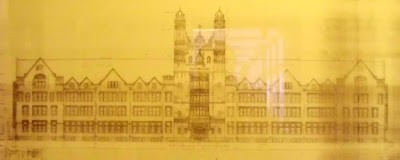Enrollment outgrew the confines in Monroe during the early 1920s. Bishop Gallagher and Mother Domitilla Donohue sought to move the college to Detroit. Mother Domitilla purchased an 80-acre wooded tract in a developing area of northwest Detroit in March, 1922, for $241,000. Indianapolis architects D.A. Bohlen & Son designed the Liberal Arts building (which houses the chapel) as well as the neighboring Madame Cadillac residence hall.
The new site suggested a new name, and in 1925, with the laying of the cornerstone of the present Liberal Arts Building, St. Mary College became Marygrove College.
The chapel features the traditional side altars to the Blessed Virgin Mary and St. Joseph, respectively.
The Sacred Heart of Jesus is depicted atop the main altar.
Fine woodworking details on the ends of the pews.
An interesting detail that I've never seen in a pew before: hinges cover small storage compartments on the top of each pew.
Large, white marble Stations of the Cross line the walls of the chapel.
The Presentation in the Temple (left) and the Wedding at Cana (right).
Parishioners of St. Peter Claver noticed water and plaster damage to the church's ceiling a few months ago. Concerned for safety, they soon moved their regularly-scheduled Sunday Mass to the Sacred Heart Chapel at Marygrove College. On January 2, the roof of the church collapsed. While the damage is extensive, there were no injuries.
To make matters even worse for the parish, a longtime pastor, Fr. James O'Reilly, passed away a few days after the roof collapsed.
St. Peter Claver will continue to hold its 10am Sunday Mass at Marygrove until they find a permanent home. Daily Mass is celebrated in the rectory next to the former Precious Blood Church.
General info about Marygrove: Marygrove.edu
Most photos of the stained glass: MarysRosaries.com On the damage to St. Peter Claver: The Michigan Catholic + Loyola High School
About the plan to close the undergrad college: Crain's Detroit, Detroit Free Press, Detroit News






















No comments:
Post a Comment